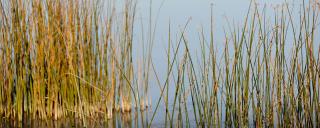
Wetland Habitats
The Game and Fish Department can cost-share on renovation and management of wetland habitats, as well as pay a rental to protect these habitats. Access for walk-in hunting is required on most cost-share agreements. The PLOTS programs for cost-share and wetland protection include Habitat Plots, Working Lands and the Wetland Reserve Incentive programs.
Wetland Habitat Introduction
Wetlands are the interface between uplands and deepwater habitat. Nearly half of North Dakota’s wetlands have been drained or filled since settlement and many are now cropped. Wetlands are areas where water saturates or inundates the ground surface, providing hydrology for a sufficiently long period of time, causing the soil to be considered hydric. Wetlands provide many functions including water storage, water quality improvement, wildlife and plant habitat and ground water infiltration. Certain plant species (hydrophytic plants), are more adapted to these sites. Several types of wetlands exist in North Dakota, including prairie pothole wetlands. These relics of the last ice age are the North American duck factory. It is important to realize all wetland types provide significant habitat for many mammals, birds and herptiles in North Dakota. Other wetland types include slope wetlands, intermittent streams, fens and bogs. Slope wetlands and intermittent streams may have areas of ponding, but for the most part, water seeps or flows downhill. Fens and bogs are unique and rare in North Dakota, exhibiting deep organic material and acidity. Fens differ from bogs by having flow-through hydrology, whereas bogs are stagnant. Some rare and beautiful plant species take advantage of the unique chemistry and hydrologic characters of these wetlands. Wetlands are classified by different characteristics such as degree of wetness, type of vegetation, water chemistry and type of bottom.
Migratory birds use small, shallow wetlands early in spring. These Type I wetlands are the first to warm and therefore the first to produce invertebrates on which birds can feed. These are particularly important as much of the calcium necessary for egg production is received through invertebrates.
Type I wetlands typically dry up within a month of the frost leaving the soil. Type III and IV wetlands provide longer duration water for waterfowl broods and other creatures. Type III wetlands typically dry up by early summer while Type IV wetlands are wet throughout the season in most years, only occasionally drying up. Type IV and V wetlands provide overwinter water for insects, fish and amphibians. These larger open waters remain ice-free later in fall, providing resting stops for migrating waterfowl.
These different types of wetlands are all important for different reasons. Most areas of the Prairie Pothole Region have diverse complexes of the various wetland types, providing varying water and vegetation conditions throughout the year. This diversity in wetland habitat ensures the life needs of all creatures that use wetlands as their habitat.
Restoration of Wetland Habitats
Wetlands are restored by returning hydrology and plants to areas that were formerly wetland or degraded wetland. Hydrology of pothole wetlands can be restored by ditch plugs, screw gates, stop logs and other structures. Sediment removal is an important aspect of wetland restoration. Accumulated sediments reduce wetland depth and increase nutrient loading, allowing for cattail domination. Wetlands that are too wet to be seeded should be left to revegetate on their own. Other wetland sites should be planted to diverse mixes of vegetation adapted to wet soils. Another method of establishment involves spreading hay with viable seed harvested from nearby wetlands. This method reduces expense, increases plant community diversity and assures that plants are adapted to the area. Restoration of slope wetlands, intermittent streams and floodplains is achieved by replacing meanders and oxbows and removing dikes as well as reestablishing native vegetation including fibrous rooted sedges and woody vegetation where appropriate.
Managing Wetland Habitats
Compared to other habitats, wetlands are low maintenance areas. The additional wetness and biomass created in wetlands provides an active food web between microbes, insects and larger consumers, reducing the need for human intervention in wetland management. Occasionally, wetlands may benefit from prescribed burns, light disking, prescribed grazing or chemical treatments. Cattail monocultures occur in some wetlands overloaded with nutrient rich sediments. These wetlands benefit from a combination of sediment removal and chemical application. Wetlands, especially cropped wetlands, are susceptible to invasion by Canada thistle, purple loosestrife, reed canary grass, phragmites and creeping foxtail. Diligence in weed control can prevent the need for broad spectrum control, which can be detrimental to plant diversity. Wetter is not always better. Periodic drying oxygenates the soil and subsequent chemical reactions are important parts of nutrient cycling and formation of hydric soils. Adding water to a wetland system may disrupt this natural process.
- Avoid adding woody vegetation adjacent to prairie pothole wetlands. Woody vegetation reduces wetland use by most waterfowl and increases mortality due to avian and mammalian predators.
- Avoid annual burning of wetland vegetation. Burning should only be prescribed on an intermittent basis for the long-term health of the wetland vegetation. Wetlands edge vegetation provides winter habitat for white-tailed deer, pheasants, sharp-tailed grouse and numerous mammals.
- Add grass buffers adjacent to wetlands in crop fields to protect against sedimentation and reduce salt accumulation along wetland edges. Tillage along wetland edges increases salt accumulation when water evaporates, leaving the salts behind.
- Wetlands attract waterfowl. Planting herbaceous vegetation on uplands adjacent to wetlands provides nesting habitat for waterfowl and other grassland birds. Grass planting adjacent to wetlands will reduce crop damage by Canada geese.
- Avoid long periods (greater than five years) of nonuse causing vegetation build-up. Wetlands should be grazed as part of a prescribed grazing system or occasionally hayed or burned to reduce plant litter accumulation. Excessive plant litter build-up impairs nutrient cycling within a wetland.
